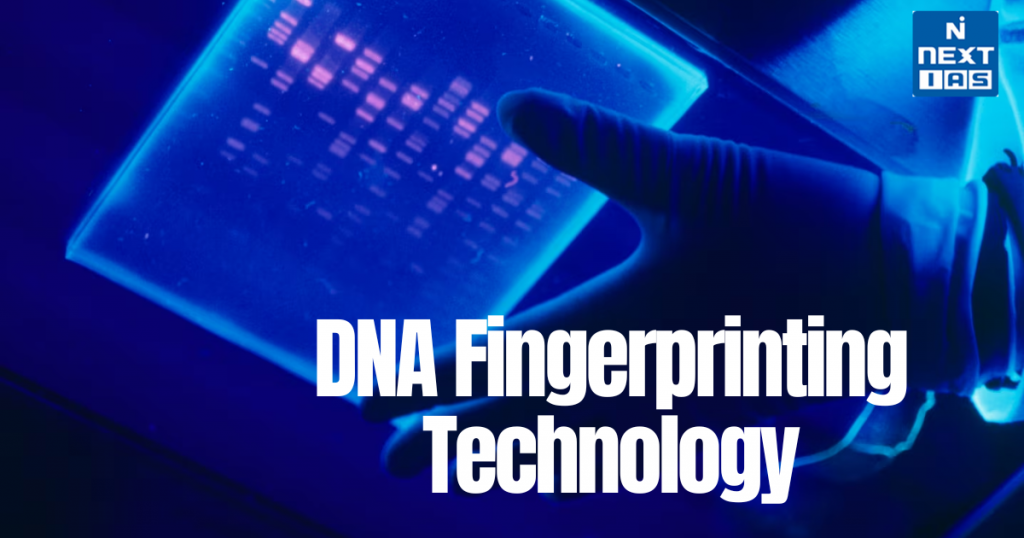
DNA fingerprinting is a forensic technique that identifies individuals based on their unique DNA patterns. Its significance lies in its wide-ranging applications, from solving crimes to establishing paternity and identifying remains. This article aims to study in detail the processes, types, and applications of DNA fingerprinting technology.
What is DNA Fingerprinting?
- DNA fingerprinting, also known as DNA profiling or typing, is a powerful forensic technique for identifying individuals based on their unique DNA patterns.
- This method relies on the fact that each person’s DNA has a unique combination of nucleotide sequences, except for identical twins who share the same DNA.
- DNA fingerprinting has many applications, including solving crimes, establishing paternity, and identifying human remains.
Key Steps in DNA Fingerprinting
The key steps in DNA Fingerprinting include:
- Sample Collection: A biological DNA sample is collected from the crime scene, individuals involved, or any relevant source.
- Common samples include blood, saliva, semen, hair, and tissues.
- DNA Extraction: DNA is extracted from the collected sample. Various methods, such as cell lysis and protein digestion, are used to break open cells and release the DNA.
- The extracted DNA is typically mixed with other cellular components.
- DNA Purification: The extracted DNA is purified to remove impurities and proteins.
- This results in a clean DNA sample, which is crucial for accurate analysis.
- Polymerase Chain Reaction (PCR): PCR is used to selectively replicate specific regions of the DNA, known as short tandem repeats (STRs) or variable number tandem repeats (VNTRs).
- These regions are highly polymorphic, meaning they vary greatly between individuals. PCR can amplify these regions even if the DNA sample is small or degraded.
- Gel Electrophoresis: The PCR-amplified DNA fragments are separated by size using gel electrophoresis.
- A gel containing tiny pores separates the DNA fragments based on their length. Smaller fragments move faster through the gel, while larger fragments move more slowly.
- DNA Visualization: After electrophoresis, the separated DNA fragments are visualised using techniques such as ethidium bromide staining or fluorescent dyes. ]
- The fragments form a distinct pattern of bands on the gel.
- Pattern Analysis: The DNA fragment pattern, often called the DNA “fingerprint,” is analysed.
- The number and size of the fragments at specific STR loci are compared between the unknown sample and known reference samples (e.g., from suspects or victims).
- Matching: If the DNA fingerprint from the unknown sample matches the DNA fingerprint of a known individual, it is considered a positive match.
- This information can be used in criminal investigations, paternity tests, and other applications.
- Statistical Analysis: Statistical calculations are often employed to assess the significance of the match.
- This helps determine the likelihood that two DNA profiles are from the same individual or unrelated individuals.
Types of DNA Fingerprinting
The types of DNA Fingerprinting are as follows:
Some of the primary types of DNA fingerprinting methods:
- Short Tandem Repeat (STR) Profiling: STR profiling is one of the most commonly used DNA fingerprinting methods in forensics and paternity testing.
- It analyses specific regions of DNA containing short repeated sequences (e.g., 4-6 base pairs).
- The number of repeats varies among individuals, creating a unique STR profile. STR profiling is highly sensitive and can be used with degraded DNA samples.
- Variable Number Tandem Repeat (VNTR) Analysis: VNTR analysis was one of the earliest DNA fingerprinting methods.
- It analyses regions of DNA containing longer repeating sequences (e.g., 10-100 base pairs).
- The number of repeats at each VNTR locus is highly variable between individuals.
- Although less commonly used today, VNTR analysis played a crucial role in the early development of DNA fingerprinting.
- Single Nucleotide Polymorphism (SNP) Profiling: SNP profiling examines single nucleotide variations at specific positions in the genome. SNPs are the most common type of genetic variation in humans.
- SNP profiles are used in genetic research, population genetics, and some clinical applications.
- Mitochondrial DNA (mtDNA) Analysis: Mitochondrial DNA is inherited solely from the mother and contains unique genetic markers.
- MtDNA analysis is often used in forensic cases where nuclear DNA is degraded or unavailable.
- It is also used to track maternal lineages and study ancient DNA.
- Y-Chromosomal DNA Analysis: This technique analyses specific regions of the Y chromosome.
- It is advantageous in paternity testing and ancestry research, as the Y chromosome is passed from father to son, allowing the tracing of paternal lineages.
- Amplified Fragment Length Polymorphism (AFLP): AFLP is a technique that generates DNA fingerprints by selectively amplifying and analysing specific fragments of genomic DNA. It has applications in genetic diversity studies and plant breeding.
- Restriction Fragment Length Polymorphism (RFLP): RFLP analysis involves digesting DNA with restriction enzymes and separating the resulting fragments by size through gel electrophoresis.
- Variations in the number and location of restriction sites lead to unique RFLP patterns.
- While an early DNA fingerprinting method, it has mainly been replaced by more modern techniques.
- Digital PCR (dPCR): Digital PCR is a quantitative method for absolute quantification of DNA fragments.
- It is used in some applications where precise quantification is crucial, such as detecting rare alleles or low-abundance genetic markers.
- Whole Genome Sequencing (WGS): While not a traditional DNA fingerprinting method, WGS involves sequencing an individual’s genome.
- The resulting sequence data can generate a comprehensive and highly informative genetic profile.
Applications of DNA Fingerprinting
The application of DNA Fingerprinting can be seen as follows:
- Criminal Investigations: DNA fingerprinting is extensively used in criminal justice to link suspects to crime scenes or to exclude innocent individuals. It can help identify perpetrators of crimes such as murder, sexual assault, burglary, and kidnapping.
- Paternity Testing: DNA fingerprinting, including paternity and maternity tests, determines biological parentage. It is invaluable in resolving child custody and inheritance and establishing legal responsibilities.
- Missing Persons and Unidentified Remains: DNA profiling is used to identify missing persons, such as those involved in accidents, natural disasters, or criminal cases. It can also help identify remains in mass graves or long-identified deceased individuals.
- Immigration and Citizenship: DNA fingerprinting can confirm biological relationships in immigration cases, where individuals are seeking to join family members in another country or establish citizenship based on familial ties.
- Forensic Genealogy: Recent advancements in DNA fingerprinting, combined with genealogical databases, have enabled the identification of suspects or victims in cold cases by tracing distant relatives through shared DNA markers.
- Wildlife Conservation: DNA profiling is used to study and monitor wildlife populations, track the illegal trade of endangered species, and combat poaching. It helps identify individuals within species, assess genetic diversity, and devise conservation strategies.
- Agriculture and Livestock Breeding: DNA fingerprinting is employed in agriculture to authenticate the origin of food products, detect food fraud, and trace livestock lineage for breeding and quality control purposes.
- Historical and Anthropological Research: DNA fingerprinting helps researchers study ancient DNA to understand human migration patterns, ancestry, and evolution. It also assists in solving historical mysteries and identifying the remains of historical figures.
- Disaster Victim Identification (DVI): In mass disasters, such as plane crashes or natural disasters, DNA fingerprinting is used to identify victims when other methods (e.g., visual identification) are impossible.
- Genealogical Research: Individuals interested in tracing their ancestry and genealogy can use DNA fingerprinting services to discover their genetic heritage and locate distant relatives.
- Consanguinity Testing: DNA fingerprinting can establish the degree of consanguinity (kinship) between individuals and determine if they share common ancestors, which can be relevant in legal matters and medical genetics.
- Quality Control in Biotechnology: DNA fingerprinting is used in biotechnology and pharmaceutical industries to verify the authenticity and purity of cell lines, microbial strains, and DNA samples.
Conclusion
In conclusion, DNA fingerprinting has transformed how we approach identification and forensic analysis, offering powerful applications across diverse fields. Its ability to link individuals to specific events, resolve familial disputes, and contribute to conservation efforts highlights its significance in modern science. As technology continues to evolve, the precision and reliability of DNA fingerprinting are expected to improve further, solidifying its role as a critical tool in justice, research, and beyond.
FAQs
What is DNA fingerprinting technology?
DNA fingerprinting is a technique used to identify individuals based on their unique genetic makeup. It analyzes specific DNA sequences, mainly short tandem repeats (STRs), to create a distinct profile. This technology is widely used in forensic science, paternity testing, and genetic research for identification and relationship verification.
Who is the father of DNA fingerprinting in India?
Dr. Lalji Singh is known as the father of DNA fingerprinting in India. He pioneered the use of this technology for forensic and diagnostic applications. His work led to the first DNA-based crime investigation in India and advancements in genetic research, including wildlife conservation and human identification.
What is the AFLP technology for DNA fingerprinting?
Amplified Fragment Length Polymorphism (AFLP) is a DNA fingerprinting technique that detects genetic variation by selectively amplifying restriction enzyme-digested DNA fragments. It is highly sensitive and used in forensic science, biodiversity studies, and genetic mapping. AFLP does not require prior DNA sequence knowledge, making it useful for diverse organisms.
What famous cases were solved by DNA fingerprinting in India?
DNA fingerprinting has solved several high-profile cases in India. Key examples include the Naina Sahni murder case (Tandoor case, 1995), where DNA confirmed the victim’s identity, and the Priyadarshini Mattoo case (1996), where DNA evidence helped convict the accused. It has also been used in paternity disputes and disaster victim identification.
What is dna fingerprinting and its application?
DNA fingerprinting is a technique that identifies individuals based on their unique genetic patterns. It analyzes specific DNA sequences, mainly short tandem repeats (STRs). Applications include forensic investigations, paternity tests, criminal identification, missing person cases, disaster victim identification, wildlife conservation, and genetic disease research in medicine and agriculture.
Why was DNA fingerprinting invented ?
DNA fingerprinting was invented to identify individuals based on unique genetic patterns. Developed by Alec Jeffreys in 1984, it was initially used for genetic research but soon became vital in forensic science, paternity testing, and criminal investigations, helping solve cases, establish biological relationships, and aid in wildlife conservation and medical studies.






